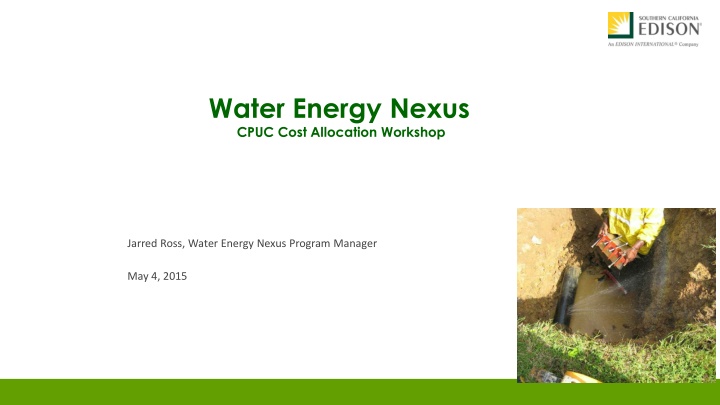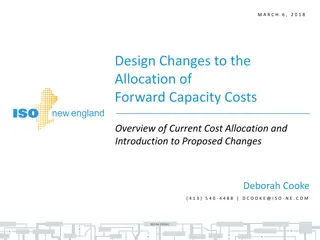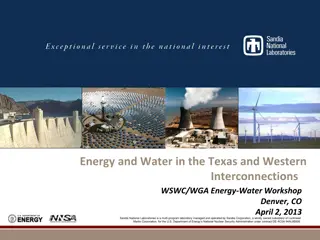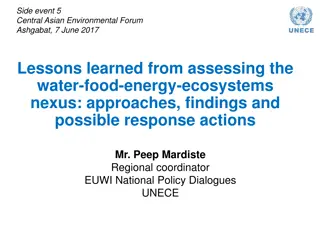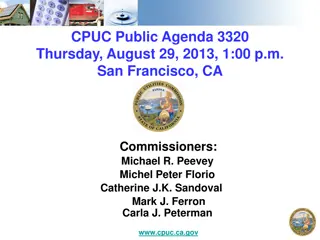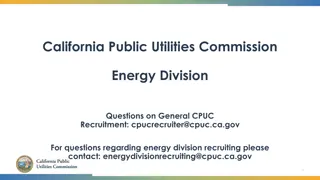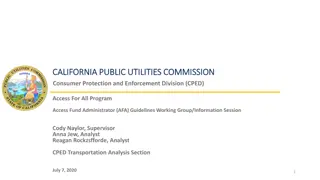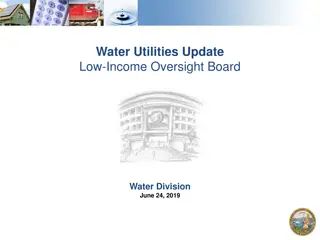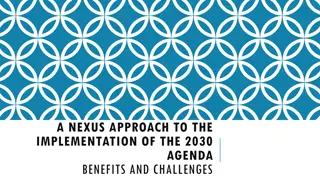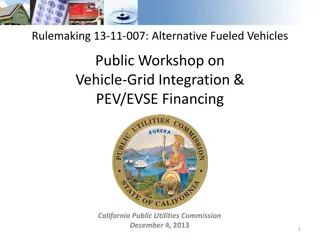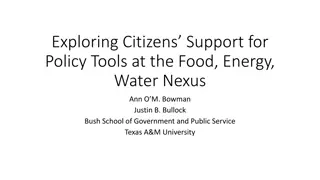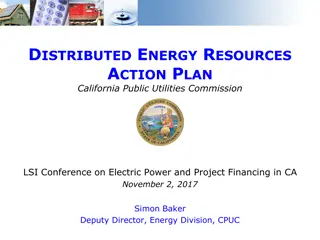Water-Energy Nexus CPUC Cost Allocation Workshop Insights
Exploring the allocation of program costs and savings credits in the Water-Energy Nexus CPUC workshop to benefit ratepayers and align budget allocations effectively. Analyzing the cost-effectiveness model and potential impacts of the ongoing drought on cost allocations.
Download Presentation

Please find below an Image/Link to download the presentation.
The content on the website is provided AS IS for your information and personal use only. It may not be sold, licensed, or shared on other websites without obtaining consent from the author.If you encounter any issues during the download, it is possible that the publisher has removed the file from their server.
You are allowed to download the files provided on this website for personal or commercial use, subject to the condition that they are used lawfully. All files are the property of their respective owners.
The content on the website is provided AS IS for your information and personal use only. It may not be sold, licensed, or shared on other websites without obtaining consent from the author.
E N D
Presentation Transcript
Water Energy Nexus CPUC Cost Allocation Workshop Jarred Ross, Water Energy Nexus Program Manager May 4, 2015
Question 1&2: How should we allocate W-E program costs and savings credit? What factors should be considered in determining cost allocations? Program costs and savings credits should be allocated in proportion to the accrual of benefits to water and energy ratepayers. The actual water capacity source per hydrologic region should be used to calculate avoided water capacity costs in order to ensure that budget allocations reflect actual avoided water capacity costs rather than default values. Cross subsidies between the two sectors should be minimized or eliminated to the extent possible by aligning budget allocations to the amount of benefits realized by water and energy ratepayers. The standard methodology (similar to what the IOU s adopted) to allocate budgets for EE measures between electric and gas should apply.
Question 3: Does the cost-effectiveness model provide sufficient information to support anticipated cost allocation processes? The model calculates separately the benefit of avoided water capacity costs and the benefit of avoided energy costs. Additional calculations need to be included to determine weighted average percentages to determine budget allocations and TRCs from each sector s perspective, as follows: ??????? ?????? ????? Energy budget allocation = ??????? ????? ???????? ?????+??????? ?????? ????? X total budget ??????? ????? ???????? ????? ??????? ????? ???????? ?????+??????? ?????? ????? X total budget Water budget allocation = Utilization of the model s override feature to change default values (where applicable) for the water capacity source to reflect the actual costs avoided and the alignment of budget allocations.
Example: SCEs Water Leak Detection Pilot: E3 EE Model vs. W-E Cost Effectiveness Model (w/o allocation of budget costs) City Gross Measure Cost kWh Savings kW Savings TRC City 1 $15,080.00 278.3 0.11 0.01 City 2 $34,788.00 18349.7 6.40 0.28 City 3 $20,221.00 6840.4 2.51 0.18 City 4 $28,101.00 10027.3 3.36 0.19 City 5 $27,834.00 914.2 0.30 0.02 TOTAL $126,024.00 36,409.9 12.68 Water Loss Cost Effectiveness Using CPUC-Navigant Draft Calculator Avoided IOU Electric Energy Cost (2014$) Avoided Water Capacity Cost (2014$) Combined Total Resource Cost Test Scenario Gallons of Water Saved City 1 530,000 $1,395.19 $18,595.99 1.42 City 2 21,550,000 $56,729.05 $756,119.79 24.98 City 3 11,040,000 $29,062.12 $387,357.89 22.02 City 4 8,410,000 $22,138.81 $295,079.69 12.07 City 5 530,000 $1,395.19 $18,595.99 0.77 TOTAL 42,060,000 13.46 $110,720.36 $1,475,749.35 4
Question 4: Does the ongoing drought impact cost allocations? The current drought could impact the cost allocation if the following occur: Cost of water commodity changes (recycled water cost reduction, not likely but it is possible) Cost of avoided energy changes (rate increases, distributed generation implementation, fuel-switching, etc.) Political considerations and impacts on efforts to save water. High societal benefits might be considered in extreme drought conditions. Potential of decreased emphasis on the use of economic theory to determine budget allocations due to drought conditions.
